It's a veterinary trend...but is it for you?
The savvy editors at Veterinary Economics are seeing more of these design elements. Here's input from expert veterinary architect Dan Chapel on the pros and cons of jumping on the bandwagon.
Next >
THE TREND
Fancy tile work
Tiny tiles with big impact-and bigger tiles with even more punch. Decorative tile checks in as a trend.
This reception desk in Bennett Creek Animal Hospital in Clarksburg, Md., is faced with one-inch-square glass mosaic tiles in a range of blues. The accent line is made with 4-inch-square ceramic tile and the countertop is Blue Pearl granite.

THE PROS
"Durability has to top the benefits list," says architect Dan Chapel, AIA. "The ruins of Pompeii boast tile elements that are 2,000 years old, after all." One word of wisdom: You need epoxy grout to repel urine in veterinary practices.
Click the Next button to view the cons.
Photo courtesy of Bennet Creek Animal Hospital
THE TREND
Fancy tile work
The upscale boarding area in Coral Springs Animal Hospital in Coral Springs, Fla., includes spacious boarding suites with brightly colored tile walls decorated in the South Beach art nouveau style.

THE CONS
Chapel says tile used to be prohibitively expensive, but because residential buildings include so much more tile than they used to, the price has come down. One downside of the upside: Tile lasts and lasts and lasts. So you need to make color and design choices you can live with for a long time.
Photo courtesy of Tim Murphy, Foto Imagery
THE TREND
Soft furnishings
Conventional wisdom: You need durable furnishings to stand up to the wear and tear of pets coming and going. The new thinking: Softer is sometimes better.
At NorthStar Vets in Robbinsville, N.J., they believe clients feel more comfortable when they have their pets close. So the practice team included pet-friendly furniture in all their client spaces. The Crypton fabric they used on the upholstery is specially designed to withstand the veterinary rigors of pet hair, bodily fluids, and nails.
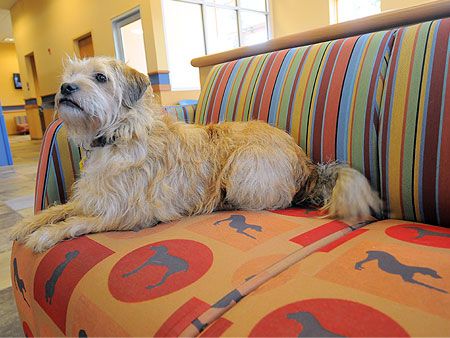
THE PROS
Manufacturers have developed much more durable fabrics, originally for the restaurant industry. And these relatively new products repel urine and resist odor. With aesthetics and expectations changing for veterinary facilities, practice owners are choosing these sophisticated furnishings more often.
Click the Next button to view the cons.
Photo courtesy of Hugh Loomis, Daniel Hedden Photography
THE TREND
Soft furnishings
Clients at Animal Surgical Clinic of Seattle, located in Shoreline, Wash., often travel long distances and will spend a lot of time waiting during surgery and other procedures. The hospital owners wanted to create calm, comfortable places for them to wait, including upholstered chairs and a rug in the main waiting area next to the fireplace.
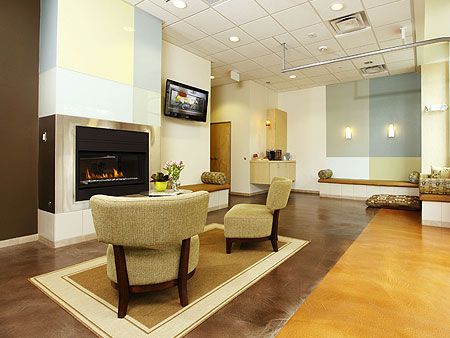
THE CONS
"Upholstered furniture became more affordable in the past 10 years," Chapel says. "So it's not as cost prohibitive to replace these pieces when they get crummy. But you will need to replace them."
Photo courtesy of Cammie Owen
THE TREND
Custom art
Statues, prints, oil paintings, and mixed media—art of every kind is finding its way into new practices.
The main lobby of Charleston Veterinary Referral Center in Charleston, S.C., features this large mural (below), painted by a local artist. The practice owners incorporated this unique piece of art to reflect Charleston’s surrounding beauty, a landscape that clients will recognize and appreciate.
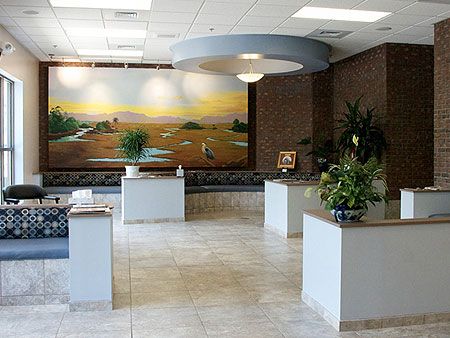
THE PROS
"The days of hanging nothing but flea life cycle posters and dogs playing poker are gone," Chapel says. "As hospitals have gotten more sophisticated in their designs, so has the art they choose to display."
Click the Next button to view the cons.
Photo courtesy of MJ Green
THE TREND
Custom art
The reception area at Antioch Veterinary Hospital in Antioch, Calif., includes two custom stretched canvas art prints by Pat Sanders-White, one of a cat and the other of the dog you see here.
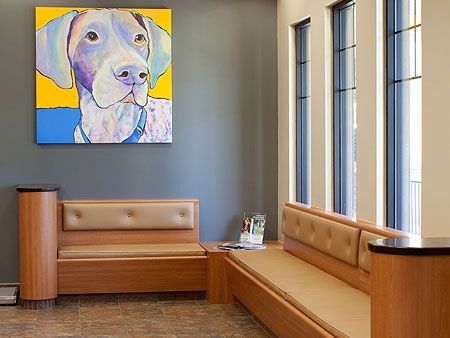
THE CONS
You want to match the style of your art to the style of your building or you'll create visual dissonance. So if you've got a very contemporary facility, keep the art modern, too. And it's easy to miss the mark with timidity, Chapel says.
"Go for something with drama. Too many small art elements won't deliver the same bang as one or two larger, more striking pieces."
Photo courtesy of Eric Rorer Photography
THE TREND
Hallway work stations
Doctors and team members clearly need space to work. But does it have to be an office? These workstations are built into core hallways.
In Coral Springs Animal Hospital, Coral Springs, Fla., workstations throughout the hospital give doctors dedicated workspace close at hand.
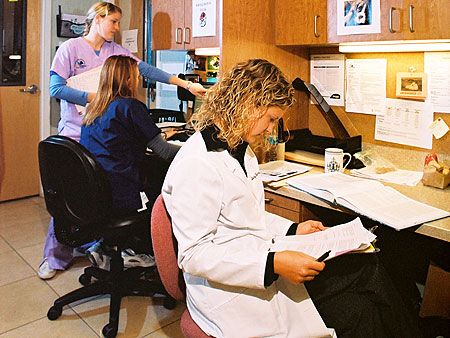
THE PROS
Offices can be tough to squeeze into the valuable real estate near the treatment area. But if office space is too far from those areas you might not really use it at all. These types of workstations represent an effort to have the best of both worlds. You could have a real office further from the heart, but you have somewhere close by to run and check files and make a call during the day.
Click the Next button to view the cons.
Photo courtesy of Tim Murphy, Foto Imagery
THE TREND
Hallway work stations
Memphis Veterinary Specialists in Cordova, Tenn., features an unusual, triangular building, and the ICU and treatment areas sit at the center of the facility. Wide hallways surround this center and double as workspace to maximize efficiency and promote staff interaction.
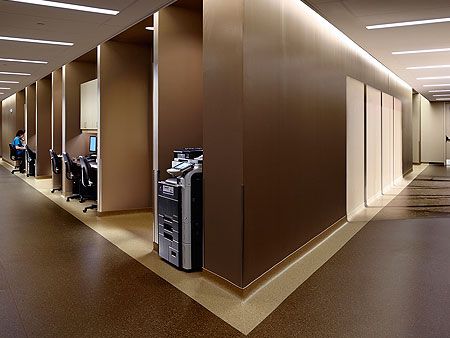
THE CONS
"It does take some space," Chapel says. "And if you have both a formal office and a work space there is some duplication. But I think it's justified with the efficiencies it brings to your day."
Photo courtesy of Ken Walker